HubSpot was founded on the idea that for businesses to grow better, they have to adapt to the ever-changing behavior of humans. It's why HubSpot created Inbound Marketing. We saw that people were tuning out outbound, interruption-based marketing tactics, and knew there had to be a better way.
We believed businesses could grow better if they stopped interrupting people and instead, focused on attracting an engaged audience. So, we made it our mission to build the tools and resources needed to help millions of businesses do just that.
It's been a decade since we've launched that mission and since then we've (literally) written the book on inbound marketing. But in 2018, based on a new set of observations, we decided to update one of the core ideas of this philosophy.
The funnel - our beloved model for growth - didn't make as much sense as it used to. It was time to retire it for something better. Something that will reflect that customers should be at the center of modern business.
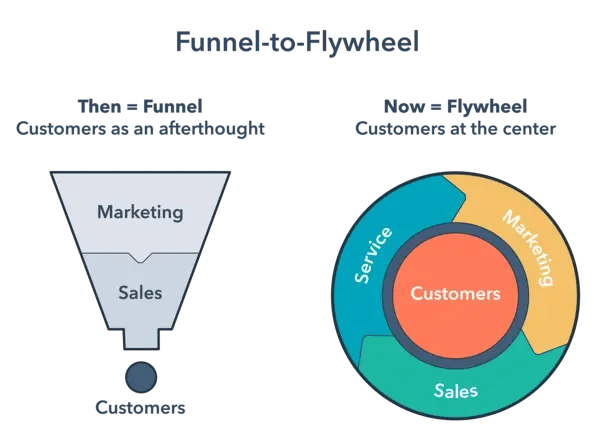
The flywheel is our new and improved model for growth. We introduced it at INBOUND 2018 and encouraged you all to "go from funnel to flywheel." It's an important change for every business to make but not exactly an easy one. To help, we gave you some tools to map out your flywheel and start to transition.
But with the flywheel, we gave you more of a template and less of a playbook like we did with inbound marketing. To help you become a flywheel business, we needed to give you a concrete roadmap with business strategies and plays to implement and invest in.
To do this, I've personally spent the majority of 2018 listening and learning from our customers — trying to understand exactly how they implement this new growth model. I studied what's working, what's not and how we can unlock that knowledge for everyone.
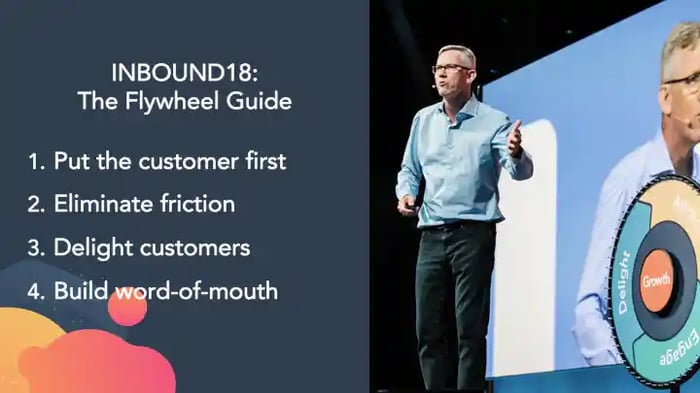
At HubSpot, I'm the GM and VP of product for Service Hub, our service product line. It's my goal to make sure that companies have the tools and strategies to make the flywheel a reality.
At INBOUND 2019, I presented what we've learned, observed and codified from Service Hub users over the last year. In this post, I'll summarize everything through the lens of the four flywheel guideposts we introduced at INBOUND 2018.
How to Create a Flywheel at Your Business
1. Put the customer first.
The biggest change the flywheel introduces is that it adds customers to your growth model. When you put the customer at the center of your business, you align your company's goals with their success. It's a recipe for sustainable, long term growth.
While most companies like to say they're "customer-first," we've found that only 12% of consumers believe a business when it says it "puts the customer first." It's a shame that companies say that they prioritize the customer yet don't act to back up that claim.
That's why we were excited about Plannuh, a Boston-based marketing software startup that put the customer first since day one. It showed us that a business can make a huge impact on customer experience when they build company systems around the customer from the start. To put customers first like Plannuh, you can take the three steps below.
Build your systems around your customers, not vice versa.
Most organizations build a system that helps them run smoother and scale, not one that necessarily is great for customers. These two things don't need to be at odds, but customers should always come before operational efficiencies.
Don't compromise your customer experience just to solve for your internal systems. Plannuh did this from the start, so it hasn't had to retool its systems to solve for upset customers.
Eliminate friction from the customer experience.
Review your customer experience to find and fight all the friction in your customer journey. For example, Plannuh knew that reaching out to support was a common friction point, so it made sure to solve that directly in its product. Plannuh includes in-app live chat because it wants to help customers as quickly and efficiently as possible. There's no doubt this approach helps reduce friction and creates happier customers in the long run.
Build a 360' view of the customer.
Plannuh makes a delightful end-to-end experience possible by having a single, unified view of its customers in the HubSpot CRM. All teams have access to contacts and with sales, service, and marketing data in one place, everyone can focus on helping customers using the relevant information at their fingertips.
Peter Mahoney, CEO of Plannuh, knew from the beginning that having a customer-first approach would be essential to his company's success. With the belief that great support should be a core part of its product, Plannuh integrated the HubSpot live chat experience.
What this does is make customers feel like they're at the center of the experience since there's no line between the product and the service team. Customers can go into the product and directly reach support whenever they need to. They don't have to go through a jarring experience whenever they need support.
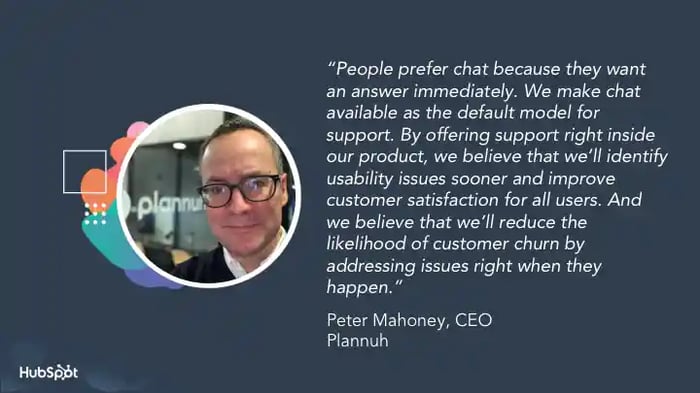
Plannuh is doing a lot right. It's shown us that to really put the customer first, you have to have a system that's flexible and wraps around customers' needs, not your systems.
That's possible in Service Hub today, but it should be a lot easier. To make it easier, we're adding more integrations and making them more accessible. This year at INBOUND we introduced an entirely redesigned integrations directory. It's now easier than ever to find and install third-party apps that'll help you build the customer experience you desire.
Learn more about Plannuh's systems here.
2. Eliminate friction between marketing, sales, and customer service.
Friction slows down your flywheel and ultimately your business growth. That's why it's important to constantly evaluate your customer journey, identify friction points, and solve them for customers.
A common friction point is reaching out to customer support. One effective way to eliminate this friction is to help customers help themselves.
We looked across our customer base at the most active knowledge base users. That's how we found MMLJ, a manufacturing company that makes industrial blast tanks, including the Dustless Blasting machine, which is a revolutionary paint stripping and cleaning system. Its team recognized the unique opportunity to empower customers to consult resources and knowledge documents that educate them about MMLJ's products. Hearing MMLJ's story helped us come up with three ways to eliminate friction in the customer journey.
Help customers at every opportunity.
When a customer has a simple question, their first move isn't to call you or go to your store, it's to search Google. To help them, you need to have robust external resources that index in Google. Customers should have the ability to find the answers they seek quickly.
Consolidate and codify knowledge.
The first step to creating amazing self-service solutions starts inside your organization. Most companies have a wealth of knowledge that could really help their customers, but it's siloed in people's brains, Google Docs, or sticky notes around the office.
MMLJ did an amazing job of uncovering this knowledge and then codifying it into documents. Those resources made it easy for it to create a world-class knowledge base and help customers at scale.
Make your knowledge public.
Once you've collected and codified knowledge, you need to find a home for it online so customers can easily access it. In Service Hub, you can do this with our knowledge base tool, but you could also use your blog, specific landing pages, community, or a simple FAQ as a way to make this information easy to access.
Before using a knowledge base, the support team at MMLJ was providing one-off answers to the same questions over and over. They had a few simple help documents and blog posts, but no searchable, customer-facing system.
MMLJ made the switch from reactive support to proactive customer service when it created a public-facing knowledge base. Before, knowledge was dispersed across the company's various departments with employees on the factory floor, front office, and back office all possessing different information. It was hard for the team to get unified answers and it added friction to the customer experience. Now, MMLJ empowers its customer base and has them benefit from knowledge and resources.
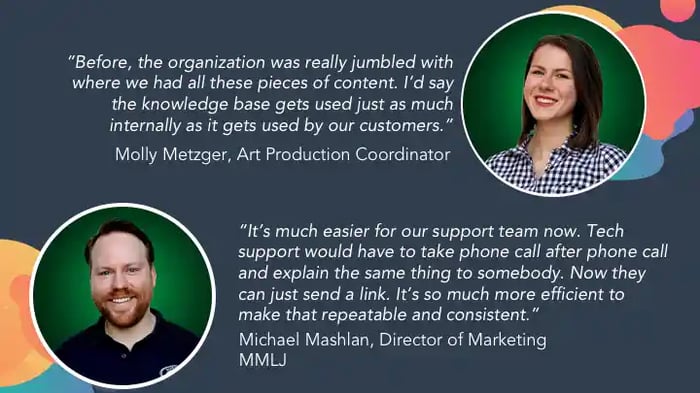
We want to continue helping businesses like MMLJ eliminate friction by adding new editor and design templates and allowing for restricted and gated article access. Since customers don't always land on the right article during their first search, we developed a related articles section that displays content driven by a machine learning model based on article category, click-through rate, and other criteria.
The related article suggestions help customers see more content that's relevant to what they're currently reading and increases their chances of success.
Learn more about how MMLJ eliminates friction for their customers here.
3. Delight your customers.
Delighting customers is easier said than done. In some ways, it's a ubiquitous business motto that doesn't get taken seriously anymore. But, research shows that customers have higher expectations than ever and are more likely to share their experiences online and in person. Put simply, customer delight is more important than ever and is key to differentiating your brand.
Customer delight is often easier when you're a small company because you have time to personalize each interaction. But as your company grows, personalization gets harder. So, how do you scale your business and continue to delight your customers?
Santa Cruz Bicycles makes high-performance off-road bicycles in California. Due to a recent period of growth, the company was looking for new ways to organize communications and scale customer work. It taught us three steps any business can take to scale customer delight as you grow.
Centralize customer communications.
When customers reach out to your business, there should be a streamlined process on the back-end that ensures a seamless customer experience on the front-end. A help desk acts as a foundation to help teams stay organized and provide solutions efficiently. Santa Cruz Bicycles uses the Conversations inbox as its hub of all customer communications to ensure inquiries don't slip through the cracks.
Keep a detailed record of your customers.
CRM's are great support tools because they track customer lifecycle stages as well as service inquiries across all departments. They provide insight into how users are interacting with your business, creating more opportunities to delight customers because you know them on a personal level. The team at Santa Cruz Bicycles makes sure to log all customer requests, so they can easily report and categorize issues.
Ensure your entire company can access customer information.
Customer service is a team sport, so every employee at your business needs to be unified in solving for the customer. Teams collaborate better cross-functionally when they have the same unified view of your customer base.
With Service Hub, Santa Cruz built a more organized system and increased its efficiency without sacrificing service quality. Today, all customers either message a "contact us" email alias or fill out a support form on the company's website for warranty issues.
In an interview with our team, Santa Cruz Support Lead, Kyle Harder, recalled how before Service Hub, there was a ton of customer data that never got collected because it was over the phone or just scattered all over. Once the team began using a centralized help desk and ticketing system, they could tie numbers to all customer inquiries and report on issues. We've learned from Santa Cruz Bicycles that centralizing and systemizing customer communications can do wonders for a support team.
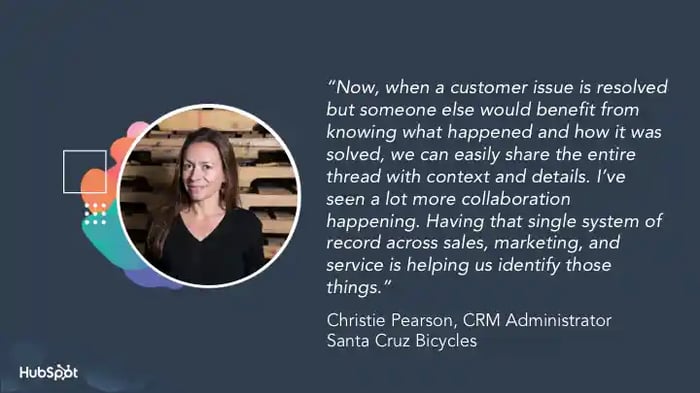
At HubSpot, we're trying to help companies like Santa Cruz Bicycles even further by continuing to build out the Conversations inbox, which acts as a response center for all customer inquiries. We also added the support form to the Conversations inbox so that teams can create and assign tickets the same way you can connect and respond to incoming emails. And, we're adding Facebook Messenger as a channel in the Conversations inbox so you're one step closer to having all customer conversations in one place.
See more about Santa Cruz Bicycles here.
4. Build up word-of-mouth marketing.
Once you've eliminated friction and provided a knowledge base, you've done a great job enhancing the customer experience. Now, with happier customers, you have an opportunity to build word-of-mouth buzz. Word-of-mouth marketing is effective because buyers are less interested in what companies say about themselves and more invested in what other customers are saying.
Complete Payroll, a company providing payroll-related services like timekeeping and "Human Capital Management," surprised us by how successful it is at identifying customer advocates. Complete Payroll helped us identify three things any company can start doing to increase word-of-mouth buzz.
Create a delightful customer experience.
A delightful customer experience is crucial to getting your flywheel to spin faster. By providing customers with an excellent experience, they become advocates for your business. With the growing importance of word-of-mouth marketing, you're essentially turning your best customers into your best marketers.
Identify happy and unhappy customers.
Identify your happy and unhappy customers by collecting feedback about their experience with your business. Then, action customer feedback by following up on negative reviews and thanking customers who left positive comments. Complete Payroll leans into advocacy automation by following up with customers whenever they leave feedback.
Help unhappy customers to amplify advocates.
Your business should have a system that reaches out to unhappy customers and actively solves their problems. This thoughtful outreach can save a customer's perception of your business, especially when they're at risk of churn.
Likewise, you should start an advocacy program that highlights the voices of your company's greatest advocates. Complete Payroll has been delighting its best customer advocates, taking its word-of-mouth marketing to the next level.
Complete Payroll is recognized for its exceptional customer service - one of the best in its industry. With Service Hub, the team creates a solid source of testimonials and uses HubSpot's NPS® tool to identify advocates.
When an NPS score is low, the team takes a closer look at the original case and analyzes why it resulted in a low score. This sets them up to quickly resolve a similar case with better results in the future. If a customer speaks highly about Complete Payroll and the NPS score is between a 9 and 10, the system automatically sends an email asking if they'd be willing to have their testimonial shared on the company's site.
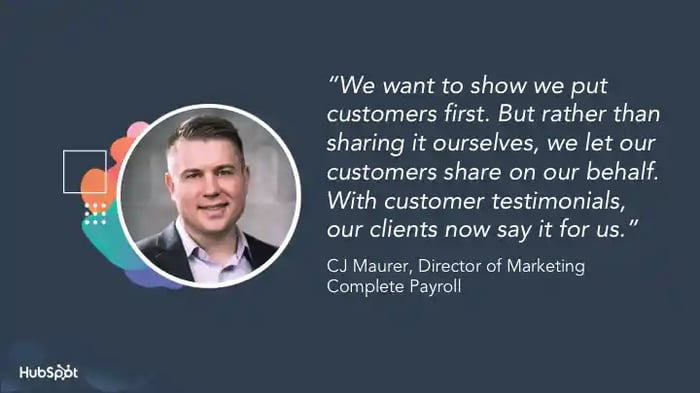
Complete Payroll is doing an amazing job amplifying the voices of advocates and turning a company's best customers into its best marketers. So, we want to make advocacy automation even easier for all of our customers.
We added embedded advocacy automation last year to help users streamline actions based on a contact's feedback. In the future, we're looking to standardize advocacy automation in our Workflows tool, as well as add improved reporting and insights on feedback data.
Read more about Complete Payroll's approach to advocacy here.
Bending Your Funnel into a Flywheel
Now that we've outlined a flywheel playbook through the lens of our customers, I'd love to recap how you can adapt this framework for your business.
1. Solve for your customer's success, not your system's.
When customers see you've designed the experience around them and not around your business system, they'll know your business truly puts the customer first.
2. Knowledge is power but only when it's free.
Yes, you want to eliminate friction in your customer journey, but you can do it more effectively by sharing knowledge. Knowledge is power when it's available to those who need it.
3. Delight your customers because it's the right thing to do.
Not because you think you're going to make more money from it. Not because I'm telling you to in a blog post. Just do it because it's the right thing to do for them and your business.
4. Humans trust humans, not companies.
It's so much better when your customers are saying what your marketing and sales teams are failing at saying. We, as buyers, intrinsically trust other humans, not companies. We trust people.
When you're a startup, marketing is your voice. When you're a scale-up, customers are your voice. When you have more and more customers, they become your voice. It's no longer enough to just have good marketing. You need to have customers advocate on your business's behalf.
Funnel-based marketing might work for some time, but you have to make this change to put customers at your center, delight them, and grow via word-of-mouth. Go forth and set your flywheel in motion today.
For more approaches to customer service, consider adopting a customer-first strategy.
Net Promoter, Net Promoter System, Net Promoter Score, NPS and the NPS-related emoticons are registered trademarks of Bain & Company, Inc., Fred Reichheld and Satmetrix Systems, Inc.








![25% of Service Reps Don't Understand Their Customers [New State of Service Data + Tips]](https://www.hubspot.com/hubfs/companies-that-listen-to-their-customers-1-20241008-1837871-1.webp)



